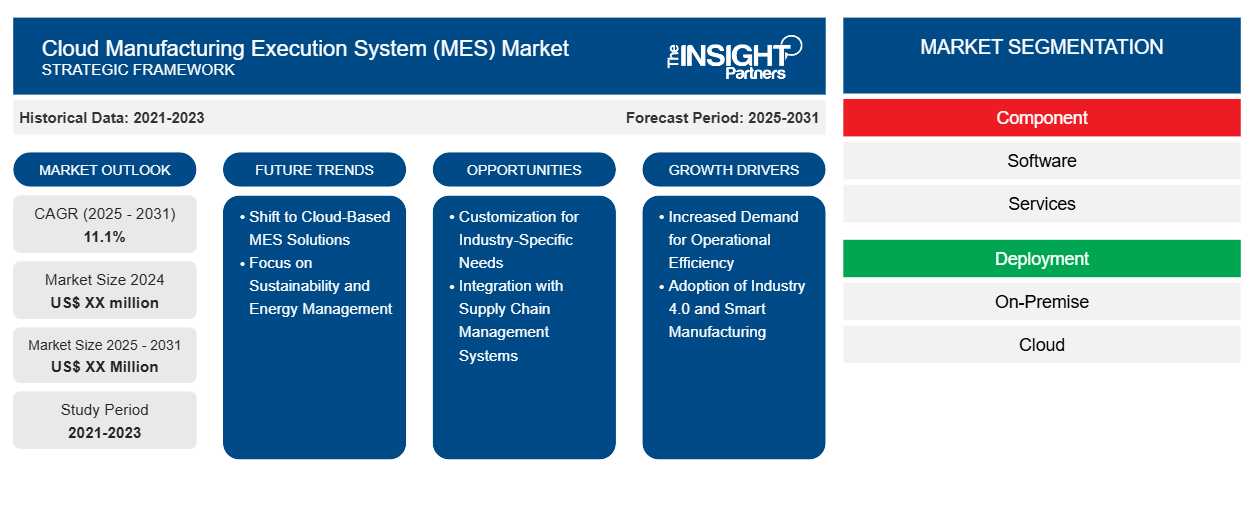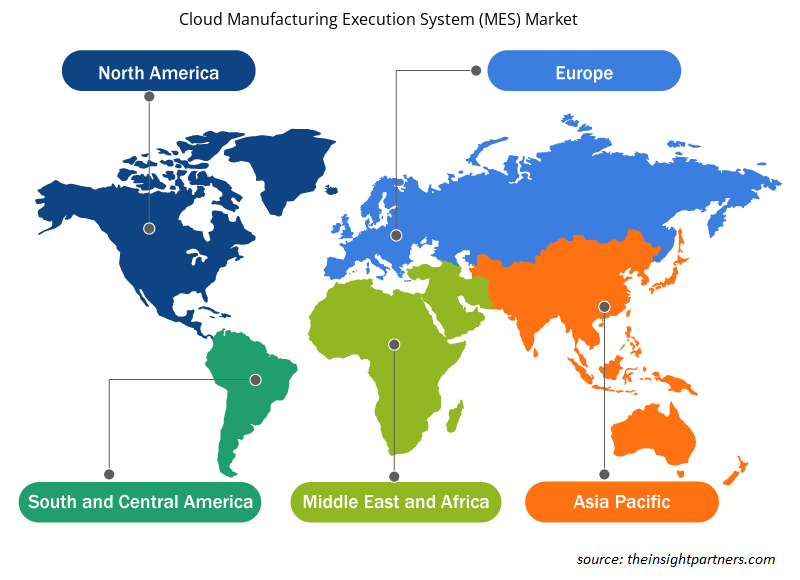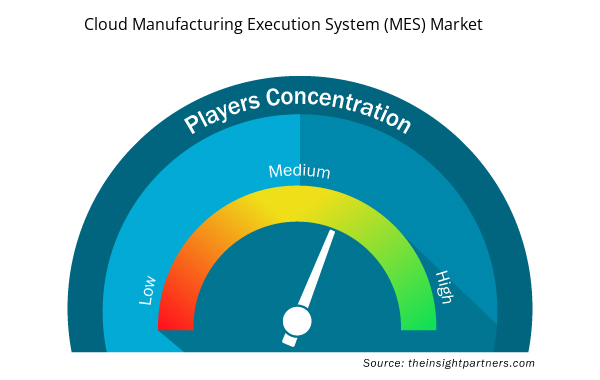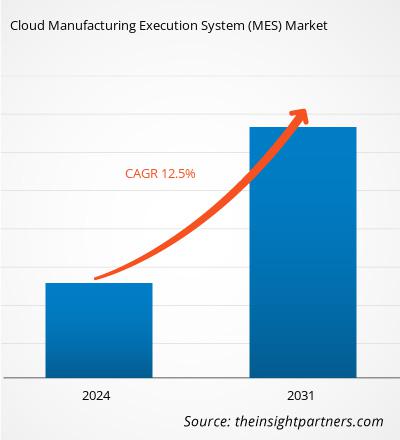クラウド製造実行システム(MES)市場規模は、2024年の106.4億米ドルから2031年には241.3億米ドルに達すると予測されています。市場は2025年から2031 年にかけて12.5%の年平均成長率(CAGR )を記録すると予測されています。デジタルツイン技術の統合拡大は、今後数年間で市場に新たなトレンドをもたらす可能性が高いでしょう。
クラウド製造実行システム(MES)市場分析
費用対効果の高いMESソリューションに対する需要の高まりは、市場の成長を牽引する主な要因の1つです。クラウドMESソリューションは、多くの場合サブスクリプションベースで提供されるため、製造業者はITインフラに投資することなく、必要なコンピューティングリソースとソフトウェアライセンスを入手できます。クラウドMESとインダストリー4.0技術の統合は、リアルタイム接続、分析の改善、予知保全、自動化の強化を可能にし、製造業を変革しています。クラウドMESシステムはカスタマイズの柔軟性を提供するため、今後数年間で需要が増加すると予想されます。また、ハイブリッドクラウドMESソリューションは、重要な製造実行機能をオンプレミスで安全かつ安全に維持しながら、重要でないデータをクラウドに転送するのに役立つため、予測期間中にハイブリッドクラウドMESソリューションの採用が増加すると予想されます。さらに、デジタルツイン技術とクラウドMESソリューションの統合は、将来的に市場に新しいトレンドをもたらすと予想されます。
クラウド製造実行システム(MES)市場概要
クラウドベースの製造実行システム(MES)は、クラウド技術を用いて製造業務を管理・最適化するための最先端のソフトウェアソリューションです。従来のオンプレミス型システムのようにローカルサーバーやインフラストラクチャに依存するシステムとは異なり、クラウドベースのMESはリモートサーバーを活用し、インターネット接続があればどこからでもリアルタイムデータと高度な分析情報を提供します。このシステムは、スケジューリング、在庫管理、品質管理、設備追跡など、あらゆる生産関連タスクのハブとして機能します。クラウドMESソフトウェアは、ERPシステムなどの他の企業テクノロジーと容易に連携し、製造プロセスの各段階を追跡・最適化するための統合プラットフォームを提供します。クラウドベースのMESの主なメリットは、その柔軟性と拡張性です。メーカーは、多額の初期費用をかけずに、生産目標に合わせてシステム機能を変更できます。サブスクリプションベースの価格モデルは、オンプレミスの代替システムに伴う財務コストと技術コストを削減し、これらのシステムをより利用しやすくしています。こうしたアクセス性、統合性、拡張性を兼ね備えたクラウドベースのMESは、生産システムのアップグレードを検討している企業にとって不可欠なツールとなっています。
要件に合わせてレポートをカスタマイズ
このレポートの一部、国レベルの分析、Excelデータパックなど、あらゆるレポートを無料でカスタマイズできます。また、スタートアップや大学向けのお得なオファーや割引もご利用いただけます。
クラウド製造実行システム(MES)市場:

- このレポートの主要な市場動向を入手してください。この無料サンプルには、市場動向から見積もりや予測に至るまでのデータ分析が含まれます。
クラウド製造実行システム(MES)市場の推進要因と機会
インダストリー4.0との統合
インダストリー4.0とクラウドMESの統合は、製造業に大きな変化をもたらします。インダストリー4.0は、モノのインターネット( IoT )、人工知能(AI)、ビッグデータ分析、スマートオートメーションといった最先端技術を活用し、インテリジェントで相互接続された生産環境を構築します。クラウドMESは、製造現場と上位の企業システム間でリアルタイムにデータを交換するためのチャネルとして機能します。この能力は、意思決定に迅速かつ信頼性の高いデータが求められるインダストリー4.0において極めて重要です。クラウドMESとIoTデバイスを組み合わせることで、製造業者は製造プロセスを包括的に把握し、ボトルネックの特定、設備の健全性の監視、リソース利用率の向上を実現できます。
IoTセンサーや AI アルゴリズムと組み合わせることで、クラウド MES は機器の故障を事前に特定できます。このプロアクティブな戦略により、ダウンタイムが短縮され、機械の寿命が延び、メンテナンス費用が削減されます。インダストリー 4.0 とクラウド MES は、製造プロセス全体のさまざまな要素を監視および管理することで、品質管理において重要な役割を果たします。高度な分析機能や AI との統合により、クラウド MES は製造サイクルの早い段階で品質上の潜在的な問題を検出し、障害を排除して、定義された要件を満たす製品だけが市場に供給されることを保証できます。MES は、サプライヤー、販売代理店、その他のサプライ チェーン パートナーとのシームレスな接続を可能にします。この相互接続により、リアルタイムの協力、需要予測、在庫管理が容易になり、より効率的で応答性の高いサプライ チェーン運用が可能になります。クラウド MES とインダストリー 4.0 テクノロジーの組み合わせは、リアルタイム接続、分析機能の向上、予知保全、自動化の強化を可能にし、工場の運用方法を変革しています。これらの機能により、メーカーは生産プロセスを合理化し、コストを削減し、品質を向上させ、全体的な運用効率を高めることができます。インダストリー 4.0 テクノロジーが広く使用されるようになると、これらの最先端の進歩をサポートするクラウド MES ソリューションの需要が高まり、市場の成長を促進します。
カスタマイズされたソリューションに対する需要の高まり
あらゆる業界のメーカーは、カスタマイズ製品や短納期への需要の高まりを背景に、顧客中心の製造戦略へと移行しています。この移行には、高度にカスタマイズされたワークフロー、柔軟な生産スケジュール、そして動的なサプライチェーン連携に対応できるMESソリューションが不可欠です。クラウドMESシステムを活用することで、企業は個々の顧客ニーズに合わせて製造プロセスを変更することができます。このシステムは、自動車、航空宇宙、食品・飲料、医薬品といった業界特有のニーズを満たすワークフローやレポート機能の設定を支援します。また、高額なインフラ投資をすることなく、カスタマイズ機能を拡張することも可能です。例えば、カスタマイズされた医療機器を製造する企業には、厳格な品質管理、バッチレベルの追跡、そして医療規制への準拠を管理できるMESソリューションが必要になる場合があります。クラウドベースのMESプラットフォームは、こうした個々の要件を満たすように簡単に設定可能です。
従来のオンプレミス型MESソリューションとは異なり、クラウドMESプラットフォームは柔軟性と拡張性に優れているため、メーカーは自社の業務要件に合わせて機能を容易にカスタマイズできます。この柔軟性は、製品設計や製造プロセスが頻繁に変更される、電子機器や消費財などのダイナミックな業界のメーカーにとって重要です。また、中小企業は独自の生産方法やリソースの制約を抱えていることが多いため、ITインフラへの大規模な初期投資を必要とせずに、特定の要件を満たすことができるクラウドMESシステムの需要が高まっています。このように、メーカーは独自の業務要件に合わせてカスタマイズできる、より柔軟で拡張性の高い業界固有のソリューションを求める傾向が強まっており、クラウドMESプラットフォームの需要は今後さらに高まると予想されます。
クラウド製造実行システム(MES)市場レポート:セグメンテーション分析
クラウド製造実行システム (MES) 市場分析の導出に貢献した主要なセグメントは、タイプとエンド ユーザーです。
- 市場は構成要素に基づいてソフトウェアとサービスに分類されます。サービスセグメントの市場はさらにプロフェッショナルサービスとマネージドサービスに分類されます。2024年にはソフトウェアセグメントが市場を支配しました。
- 導入の観点から、市場はプライベートクラウド、パブリッククラウド、ハイブリッドクラウドに分類されます。2024年にはパブリッククラウドセグメントが市場を支配しました。
- 組織規模別に、市場は中小企業と大企業に分類されます。2024年には大企業セグメントが市場を支配しました。
- 販売チャネル別に見ると、市場は直接販売とチャネルパートナーに分類されます。2024年には、直接販売セグメントが市場を支配しました。
- エンドユーザー別に見ると、市場はプロセス産業とディスクリート産業に分類されます。プロセス産業セグメントの市場は、食品・飲料、石油・ガス、化学、パルプ・紙、化学、エネルギー・電力、医薬品・ライフサイエンス、水・廃水処理、その他に分類されます。ディスクリート産業セグメントの市場は、自動車、電子機器、半導体、航空宇宙・防衛、消費財、医療機器、その他に分類されます。2024年には、ディスクリート産業セグメントが市場を牽引しました。
- 監視タイプ別に見ると、クラウド製造実行システム(MES)市場は、リアルタイム温度追跡、エネルギー管理、製品鮮度監視、データロギングと分析、その他に分類されます。2024年には、リアルタイム温度追跡セグメントが市場を席巻しました。
クラウド製造実行システム(MES)の地域別市場シェア分析
クラウド製造実行システム (MES) 市場は、北米、ヨーロッパ、アジア太平洋 (APAC)、中東およびアフリカ (MEA)、南米および中米の 5 つの主要地域に分類されています。
北米の主要国には、米国、カナダ、メキシコがあります。この地域は、IoT、AI、機械学習、高度な分析などのインダストリー4.0テクノロジーとの統合を特徴とするMES 4.0の導入において先駆者となっています。MES 4.0への移行は、よりスマートで効率的な製造オペレーション、リアルタイムデータ、製造現場とエンタープライズシステム間のシームレスな接続に対するニーズによって主に推進されています。産業界がデジタルトランスフォーメーションにますます重点を置くようになるにつれて、MES 4.0はスマート製造のためのインフラストラクチャを提供し、リアルタイムの意思決定、予知保全、生産の柔軟性の向上を可能にします。SepasoftはMES 4.0を提供し、継続的インテグレーションと継続的デプロイメント(CI/CD)を合理化し、パフォーマンスと安定性を強化し、将来を見据えた運用を支援するツールスイートを提供します。変更セット機能によりMESデプロイメントを完全に制御できるほか、Ignition 8.3との互換性により、イベントストリームなどの強力な新機能が利用可能になります。
北米諸国の産業界は、紙ベースの文書使用量の削減、文書保管業務の簡素化、エラーが発生しやすいプロセスの排除、データアクセスと分析の改善を目的として、クラウドMESソリューションを導入しています。また、この地域の市場プレーヤーは、より高度なソリューションを顧客に提供するために、継続的なイノベーションに取り組んでいます。例えば、2022年12月には、Tulip社がアマゾン ウェブ サービス(AWS)ソリューションライブラリでクラウド製造実行システム(MES)をリリースし、企業に費用対効果が高くスケーラブルなMESソリューションを提供しています。Tulip社のコンポーザブルプラットフォームとAWSのリアルタイムデータアクセスと信頼性を組み合わせることで、企業はクラウドベースのMESを活用し、業務を変革することができます。
クラウド製造実行システム(MES)市場の地域別分析
Insight Partnersのアナリストは、予測期間を通じてクラウド製造実行システム(MES)市場に影響を与える地域的なトレンドと要因を詳細に解説しています。このセクションでは、北米、ヨーロッパ、アジア太平洋、中東・アフリカ、中南米におけるクラウド製造実行システム(MES)市場のセグメントと地域についても解説します。

- クラウド製造実行システム(MES)市場の地域別データを入手
クラウド製造実行システム(MES)市場レポートの範囲
| レポート属性 | 詳細 |
|---|---|
| 2024年の市場規模 | 106億4000万米ドル |
| 2031年までの市場規模 | 241億3000万米ドル |
| 世界のCAGR(2025年~2031年) | 12.5% |
| 履歴データ | 2021-2023 |
| 予測期間 | 2025~2031年 |
| 対象セグメント | コンポーネント別
|
| 対象地域と国 | 北米
|
| 市場リーダーと主要企業の概要 |
|
クラウド製造実行システム(MES)市場のプレーヤー密度:ビジネスダイナミクスへの影響を理解する
クラウド製造実行システム(MES)市場は、消費者の嗜好の変化、技術の進歩、製品メリットへの認知度の向上といった要因によるエンドユーザー需要の高まりに牽引され、急速に成長しています。需要が高まるにつれ、企業は提供内容を拡大し、消費者ニーズを満たすためのイノベーションを推進し、新たなトレンドを捉えることで、市場の成長をさらに加速させています。
市場プレーヤー密度とは、特定の市場または業界内で事業を展開する企業または会社の分布を指します。これは、特定の市場空間における競合企業(市場プレーヤー)の数が、その市場規模または市場価値全体と比較してどれだけ多いかを示します。
クラウド製造実行システム(MES)市場で事業を展開している主要企業は次のとおりです。
- アプレンティスFS株式会社
- 42Q
- SAP SE
- ABB株式会社
- シュナイダーエレクトリックSE
- インフォア
免責事項:上記の企業は、特定の順序でランク付けされているわけではありません。

- クラウド製造実行システム(MES)市場のトップキープレーヤーの概要を入手
クラウド製造実行システム(MES)市場ニュースと最新動向
クラウド製造実行システム(MES)市場は、主要な企業出版物、協会データ、データベースなどを含む一次調査および二次調査に基づく定性・定量データの収集によって評価されます。クラウド製造実行システム(MES)市場における動向の一部を以下に示します。
- IBASET INCは、英国のTeledyne CML Composites社が、同社の製造現場オペレーションを革新するため、iBase-tのSolumina製造実行システムとエンタープライズ品質管理システムを選定したことを発表しました。このパートナーシップにより、Teledyne社はコストとサイクルタイムの削減機会を特定し、実装するとともに、技術者の採用とトレーニングにおける主要な課題に対処することができます。(出典:IBASET INC、プレスリリース、2025年2月)
- ハネウェルは、ギガファクトリーの運用を初日から最適化するために設計されたAI搭載ソフトウェア、バッテリー製造エクセレンス・プラットフォーム(Battery MXP)を発表しました。バッテリーセルの歩留まりを向上させ、施設の立ち上げを迅速化することで、従来のソリューションでは30%にも達する可能性のある材料廃棄率を削減し、メーカーの生産規模拡大に伴うエネルギーと材料コストの削減に貢献します。(出典:ハネウェル、プレスリリース、2024年6月)
クラウド製造実行システム(MES)市場レポートの対象範囲と成果物
「クラウド製造実行システム(MES)市場規模と予測(2021〜2031年)」では、以下の分野を網羅した市場の詳細な分析を提供しています。
- クラウド製造実行システム(MES)市場規模と予測(スコープに含まれるすべての主要市場セグメントの世界、地域、国レベル)
- クラウド製造実行システム(MES)市場の動向、および推進要因、制約、主要な機会などの市場動向
- 詳細なPEST分析とSWOT分析
- クラウド製造実行システム(MES)市場分析では、主要な市場動向、世界および地域の枠組み、主要プレーヤー、規制、最近の市場動向を網羅しています。
- クラウド製造実行システム(MES)市場の市場集中、ヒートマップ分析、主要プレーヤー、最近の動向を網羅した業界の展望と競争分析
- 詳細な企業プロフィール
- 過去2年間の分析、基準年、CAGRによる予測(7年間)
- PEST分析とSWOT分析
- 市場規模価値/数量 - 世界、地域、国
- 業界と競争環境
- Excel データセット



Report Coverage
Revenue forecast, Company Analysis, Industry landscape, Growth factors, and Trends

Segment Covered
This text is related
to segments covered.

Regional Scope
North America, Europe, Asia Pacific, Middle East & Africa, South & Central America

Country Scope
This text is related
to country scope.
よくある質問
The key players holding majority shares in the global cloud manufacturing execution system (MES) market are Apprentice FS Inc; 42Q; SAP SE; ABB Ltd; Schneider Electric SE; Infor; Korber AG; General Electric Co; Rockwell Automation Inc; Siemens AG; PSI Software SE; EAZYWORKS INC.; Eyelit Technologies; Glorysoft (Shanghai) Co.,Ltd.; Oracle Corp; Autodesk Inc; International Business Machines Corp; IFS AB; FA software (Shanghai) Co., Ltd; Epicor Software Corp; IBASET INC; ANT Sp. z o.o.; NoMuda Ltd; Symestic GmbH; and Tulip Interfaces, Inc.
Growing integration of digital twin technology to play a significant role in the global cloud manufacturing execution system (MES) market in the coming years.
Rising demand for cost-effective MES solutions and integration with Industry 4.0 are the major factors that propel the global cloud manufacturing execution system (MES) market.
Asia Pacific dominated the cloud manufacturing execution system (MES) market in 2024.
The global cloud manufacturing execution system (MES) market is expected to reach US$ 24.13 billion by 2031.
The global cloud manufacturing execution system (MES) market is estimated to register a CAGR of 12.5% during the forecast period 2024–2031.
Trends and growth analysis reports related to Technology, Media and Telecommunications : READ MORE..
The List of Companies - Cloud Manufacturing Execution System (MES) Market
- Apprentice FS Inc
- Epicor Software Corp
- IBASET INC
- ANT Sp. z o.o.
- NoMuda Ltd
- Symestic GmbH
- Tulip Interfaces, Inc
- General Electric Co
- Rockwell Automation Inc
- Siemens AG
- PSI Software SE
- Eyelit Technologies
- Glorysoft (Shanghai) Co., Ltd.
- Oracle Corp
- Autodesk Inc
- International Business Machines Corp
- IFS AB
- FA software (Shanghai) Co., Ltd
- SAP SE
- ABB Ltd
- Schneider Electric SE
- 42Q
- Infor
- Korber AG
The Insight Partners performs research in 4 major stages: Data Collection & Secondary Research, Primary Research, Data Analysis and Data Triangulation & Final Review.
- Data Collection and Secondary Research:
As a market research and consulting firm operating from a decade, we have published and advised several client across the globe. First step for any study will start with an assessment of currently available data and insights from existing reports. Further, historical and current market information is collected from Investor Presentations, Annual Reports, SEC Filings, etc., and other information related to company’s performance and market positioning are gathered from Paid Databases (Factiva, Hoovers, and Reuters) and various other publications available in public domain.
Several associations trade associates, technical forums, institutes, societies and organization are accessed to gain technical as well as market related insights through their publications such as research papers, blogs and press releases related to the studies are referred to get cues about the market. Further, white papers, journals, magazines, and other news articles published in last 3 years are scrutinized and analyzed to understand the current market trends.
- Primary Research:
The primarily interview analysis comprise of data obtained from industry participants interview and answers to survey questions gathered by in-house primary team.
For primary research, interviews are conducted with industry experts/CEOs/Marketing Managers/VPs/Subject Matter Experts from both demand and supply side to get a 360-degree view of the market. The primary team conducts several interviews based on the complexity of the markets to understand the various market trends and dynamics which makes research more credible and precise.
A typical research interview fulfils the following functions:
- Provides first-hand information on the market size, market trends, growth trends, competitive landscape, and outlook
- Validates and strengthens in-house secondary research findings
- Develops the analysis team’s expertise and market understanding
Primary research involves email interactions and telephone interviews for each market, category, segment, and sub-segment across geographies. The participants who typically take part in such a process include, but are not limited to:
- Industry participants: VPs, business development managers, market intelligence managers and national sales managers
- Outside experts: Valuation experts, research analysts and key opinion leaders specializing in the electronics and semiconductor industry.
Below is the breakup of our primary respondents by company, designation, and region:

Once we receive the confirmation from primary research sources or primary respondents, we finalize the base year market estimation and forecast the data as per the macroeconomic and microeconomic factors assessed during data collection.
- Data Analysis:
Once data is validated through both secondary as well as primary respondents, we finalize the market estimations by hypothesis formulation and factor analysis at regional and country level.
- Macro-Economic Factor Analysis:
We analyse macroeconomic indicators such the gross domestic product (GDP), increase in the demand for goods and services across industries, technological advancement, regional economic growth, governmental policies, the influence of COVID-19, PEST analysis, and other aspects. This analysis aids in setting benchmarks for various nations/regions and approximating market splits. Additionally, the general trend of the aforementioned components aid in determining the market's development possibilities.
- Country Level Data:
Various factors that are especially aligned to the country are taken into account to determine the market size for a certain area and country, including the presence of vendors, such as headquarters and offices, the country's GDP, demand patterns, and industry growth. To comprehend the market dynamics for the nation, a number of growth variables, inhibitors, application areas, and current market trends are researched. The aforementioned elements aid in determining the country's overall market's growth potential.
- Company Profile:
The “Table of Contents” is formulated by listing and analyzing more than 25 - 30 companies operating in the market ecosystem across geographies. However, we profile only 10 companies as a standard practice in our syndicate reports. These 10 companies comprise leading, emerging, and regional players. Nonetheless, our analysis is not restricted to the 10 listed companies, we also analyze other companies present in the market to develop a holistic view and understand the prevailing trends. The “Company Profiles” section in the report covers key facts, business description, products & services, financial information, SWOT analysis, and key developments. The financial information presented is extracted from the annual reports and official documents of the publicly listed companies. Upon collecting the information for the sections of respective companies, we verify them via various primary sources and then compile the data in respective company profiles. The company level information helps us in deriving the base number as well as in forecasting the market size.
- Developing Base Number:
Aggregation of sales statistics (2020-2022) and macro-economic factor, and other secondary and primary research insights are utilized to arrive at base number and related market shares for 2022. The data gaps are identified in this step and relevant market data is analyzed, collected from paid primary interviews or databases. On finalizing the base year market size, forecasts are developed on the basis of macro-economic, industry and market growth factors and company level analysis.
- Data Triangulation and Final Review:
The market findings and base year market size calculations are validated from supply as well as demand side. Demand side validations are based on macro-economic factor analysis and benchmarks for respective regions and countries. In case of supply side validations, revenues of major companies are estimated (in case not available) based on industry benchmark, approximate number of employees, product portfolio, and primary interviews revenues are gathered. Further revenue from target product/service segment is assessed to avoid overshooting of market statistics. In case of heavy deviations between supply and demand side values, all thes steps are repeated to achieve synchronization.
We follow an iterative model, wherein we share our research findings with Subject Matter Experts (SME’s) and Key Opinion Leaders (KOLs) until consensus view of the market is not formulated – this model negates any drastic deviation in the opinions of experts. Only validated and universally acceptable research findings are quoted in our reports.
We have important check points that we use to validate our research findings – which we call – data triangulation, where we validate the information, we generate from secondary sources with primary interviews and then we re-validate with our internal data bases and Subject matter experts. This comprehensive model enables us to deliver high quality, reliable data in shortest possible time.

 このレポートの無料サンプルを入手する
このレポートの無料サンプルを入手する